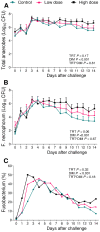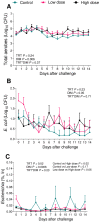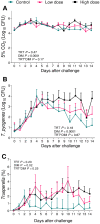Testing the Induction of Metritis in Healthy Postpartum Primiparous Cows Challenged with a Cocktail of Bacteria
- PMID: 37760254
- PMCID: PMC10525343
- DOI: 10.3390/ani13182852
Testing the Induction of Metritis in Healthy Postpartum Primiparous Cows Challenged with a Cocktail of Bacteria
Abstract
Metritis is a postpartum uterine disease with greater incidence in primiparous than in multiparous cows. In primiparous cows, the impact on production and health is lessened, presumably due to a superior immune response. Here, we tested whether an in vivo model of clinical metritis induction developed for postpartum multiparous Holstein cows would produce similar results in primiparous cows. Thirty-six cows were randomly assigned to one of three groups and received intrauterine infusion within 24 h of parturition. The controls were infused with sterile saline; the low-dose group received a bacterial cocktail containing 103 cfu of Escherichia coli, Trueperella pyogenes, and Fusobacterium necrophorum; and the high-dose group were infused with 106 cfu of the same cocktail. Production, health traits, and the vaginal discharge culture were assessed daily, from enrollment until 14 d in milk. Clinical metritis occurred in 64% of high-dose cows, 33% of the controls, and 42% of low-dose cows, with no significant difference of incidence between groups. However, when accounting by time, high-dose cows had a 2.7 times greater hazard of metritis compared with the controls. The bacterial challenge affected milk production and dry matter intake tended to decrease. In the high-dose group, a greater growth of F. necrophorum in the selective medium was also observed, suggesting an association with metritis. Therefore, this study suggests intrauterine inoculation with 106 cfu of this bacterial cocktail elicits physical and clinical outcomes consistent with clinical metritis.
Keywords: challenge; dairy cow; metritis; microbiota; primiparous.
Conflict of interest statement
The authors declare no conflict of interest. The funderhelped the research group with statistical analysis and revision of the manuscript prior to publication.
Figures









Similar articles
-
Reanalysis of 2 metritis studies demonstrates different patterns of postpartum uterine infection for primiparous versus multiparous cows.JDS Commun. 2025 Jan 16;6(3):362-367. doi: 10.3168/jdsc.2024-0679. eCollection 2025 May. JDS Commun. 2025. PMID: 40458149 Free PMC article.
-
Intrauterine infusion of a pathogenic bacterial cocktail is associated with the development of clinical metritis in postpartum multiparous Holstein cows.J Dairy Sci. 2023 Jan;106(1):607-623. doi: 10.3168/jds.2022-21954. Epub 2022 Nov 16. J Dairy Sci. 2023. PMID: 36400620
-
Effect of calving season on metritis incidence and bacterial content of the vagina in dairy cows.Theriogenology. 2022 Oct 1;191:67-76. doi: 10.1016/j.theriogenology.2022.08.001. Epub 2022 Aug 6. Theriogenology. 2022. PMID: 35970030
-
Symposium review: The uterine microbiome associated with the development of uterine disease in dairy cows.J Dairy Sci. 2019 Dec;102(12):11786-11797. doi: 10.3168/jds.2019-17106. Epub 2019 Oct 3. J Dairy Sci. 2019. PMID: 31587913 Review.
-
Rumination time as an early predictor of metritis and subclinical ketosis in dairy cows at the beginning of lactation: Systematic review-meta-analysis.Prev Vet Med. 2021 Apr;189:105309. doi: 10.1016/j.prevetmed.2021.105309. Epub 2021 Feb 23. Prev Vet Med. 2021. PMID: 33689960
Cited by
-
Reanalysis of 2 metritis studies demonstrates different patterns of postpartum uterine infection for primiparous versus multiparous cows.JDS Commun. 2025 Jan 16;6(3):362-367. doi: 10.3168/jdsc.2024-0679. eCollection 2025 May. JDS Commun. 2025. PMID: 40458149 Free PMC article.
-
Histophilus somni as a Unique Causative Agent of Puerperal Metritis (PM) in a Third-Lactation Holstein Cow.Vet Sci. 2024 Mar 5;11(3):117. doi: 10.3390/vetsci11030117. Vet Sci. 2024. PMID: 38535851 Free PMC article.
References
LinkOut - more resources
Full Text Sources

